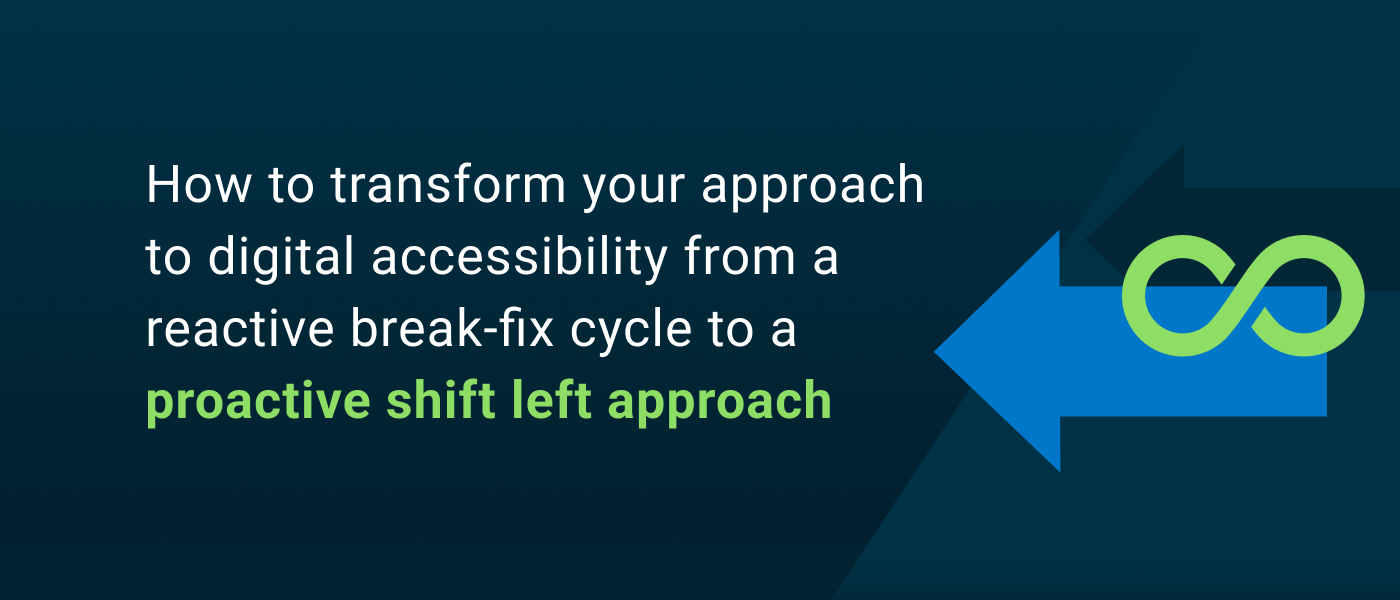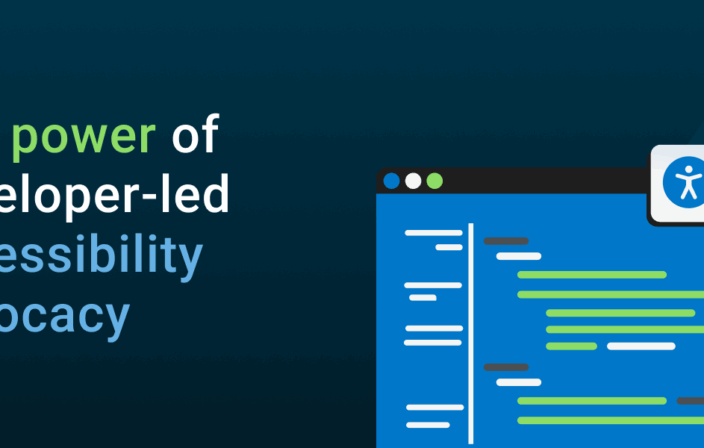There are two ways organizations typically approach digital accessibility. One approach is proactive. It’s efficient, cost-effective, and results in better and more accessible products. The other approach is reactive. It’s expensive, inefficient, and continues to expose users to accessibility barriers.
As you read that, you’re probably thinking, why would any business choose the reactive approach?
That’s a great question! The problem is that organizations don’t always realize they’re taking a reactive approach to digital accessibility.
Understanding how your organization can end up stuck in a reactive mode is the first step toward transformation.
How organizations get stuck in reactive break-fix cycles
Accessibility efforts at an organization often begin in response to an unexpected trigger or catalyst.
These catalyst events come in different forms. You might be selling your product to a business when they suddenly demand digital accessibility and a VPAT (Voluntary Product Accessibility Template) or Accessibility Conformance Report (ACR). Or, you might receive a demand letter from a law firm representing an individual demanding digital accessibility. New legislation might get passed that you’re not prepared for.
In all these kinds of cases, your response is, by definition, reactive.
A reactive response generally involves a decision to find and fix accessibility issues, which can quickly become overwhelming. Initial automated and guided testing will often reveal thousands (if not tens of thousands) of defects. These typically get passed to already busy development teams to fix without accounting for the extra time required to do the accessibility work.
This situation gets exacerbated because, even as some development teams are working to address a backlog of accessibility issues, other teams are carrying on with updating and creating new content, unaware of any accessibility requirements. You end up fixing broken things over here while creating new broken things over there. Before you know it, your organization is stuck, trapped in an endless break-fix cycle.
At this juncture, many organizations call in an accessibility partner. But too often, it’s for the wrong reasons. You don’t need another audit and another list of broken things to fix. You need guidance on escaping this reactive break-fix cycle and moving toward a proactive approach that focuses on accessibility from the start.
This approach is called “shifting left.”
It involves conducting accessibility testing early in the design and development stages and catching accessibility issues sooner. When your organization shifts left, you save money, free up your teams, and create better and more accessible products.
How organizations can shift left and get proactive about digital accessibility
Shifting accessibility testing to earlier in the design process may initially sound fairly straightforward. But in actual practice, fully embracing a shift-left approach at a company-wide level involves more than just a change in process. The effort also involves time and resources, education and training, new tools and techniques, and more.
[shift-left-full]
The payoff is well worth it, and everyone will benefit, from accessibility leaders to your CFO to your product owners—not to mention your content development teams! But you’ll need to frontload the investment because it’s not realistic to expect your teams to consistently produce accessible content without setting them up for success.
Accordingly, the most important prerequisite for shifting left is that all relevant teams need to be fully enabled to practice shift-left accessibility.
We can think of this in terms of five “obligations of accessibility.” These are the things you need to provide in order to ensure it’s possible for your organization and your teams to produce accessible content in the most efficient manner.
5 obligations of accessibility
- The inclination to practice digital accessibility
There are three important actions that are required to make this possible across an organization. You need to obtain executive buy-in, create and enforce an accessibility policy, and run an accessibility awareness campaign. C-suite backing ensures accessibility remains a priority, an accessibility policy lays out the path to success, and awareness campaigns help employees understand why accessibility matters and how they can help.
- Time to do the work
Planning the time to add accessibility requirements into design, development, and testing is critical to success. In an organization with little accessibility testing automation, the overall cost can be as much as 15% of software development life cycle time.
- Education and training to understand how to do the work
Success depends on everyone in the organization understanding more about accessibility, assistive technologies, and disability. Learning how to design with accessibility in mind and applying it within your tech stack is a large undertaking that requires education and training. People will need to learn new tools and skills, as well as new concepts and practices.
- Access to expert resources to support ongoing work
As technology changes and evolves, so too does our ability to create new tools and techniques that support accessibility. Our understanding of disability continues to improve as well. And with every advancement, new laws are written, and new guidelines are developed. The work of accessibility continues as things change, and it’s essential to have expert guidance to stay on top of it all.
- The automation and tools required to shift left and drive success
Reaching an efficient and sustainable practice of accessibility requires automating as much as possible at every juncture of content development. Procurement, implementation, and roll-out of these tools is a must-have to enable a shift-left approach.
The tools to shift left
Number five is a uniquely critical component, and I’d like to take an additional moment to briefly discuss the role automation and tools play in the shift left approach.
Your developers are the beating heart of digital accessibility work, and it’s critical they have the tools they need. And those tools need to deliver the right results, because winning over your development teams is essential when it comes to transformative long-term change. Acceptable tools must be fast, accurate, easy to use, and integrated into developers standard workflows.
For example, tools that return false positives will derail your plans. Nothing subverts credibility more than having to chase issues that are not actually issues, and high rates of false positives pretty much guarantee your teams will stay trapped in that break-fix cycle.
It’s also important that tools are appropriately tailored to your team’s levels of expertise. You can provide automation tools to novice developers and get 80% issue coverage right out of the gate while simultaneously enabling more experienced teams with advanced insights as they’re conducting manual testing.
Prioritization is yet another key piece of the puzzle. Developers need to know they’re focusing on the most critical issues and not wasting time on low-priority issues, or, worse, duplicates.
Transforming from break-fix to shift left
Freeing up staff to address accessibility issues can be a challenge. Fortunately, products such as Deque’s axe Developer Hub make it easy to add accessibility testing to end-to-end tests. Your developers can find new issues and get feedback while coding in the IDE and within pull requests. And with a toolkit like axe DevTools, your organization can quickly get to 80% accessibility issue coverage.
Solutions like these that fit your team’s current workflow are the key to successfully implementing a shift left approach.
Conclusion
Exiting the reactive break-fix cycle and moving to a proactive shift left approach is about getting started and building momentum. This can happen one team, one department, even one issue at a time. Every single removal of an accessibility barrier will have a positive downstream impact. And by taking an iterative approach and proving early results, accessibility leaders can energize and motivate other teams to begin prioritizing accessibility.
As your successes increase and your efforts expand, you’ll need to continue making resourcing and funding decisions, and there will be ongoing work for your centralized accessibility team. Fortunately, we have seen that early success creates a “positive pull motion,” where entire development organizations realize that fixing issues early makes their lives easier and delivers improved quality for all.
The results are transformational, with everything becoming easier, more efficient, and streamlined over time. Your organization will lower costs and see increasing ROI on the investment. Your product owners will reclaim the full ability to evolve their products.
Digital accessibility is a win for everyone, and achieving it at scale means getting proactive, shifting left, and breaking the break-fix cycle.




